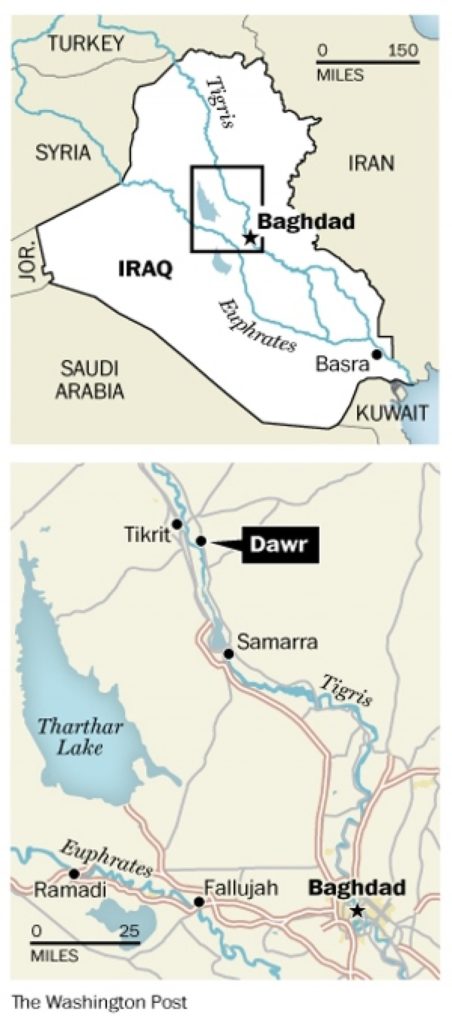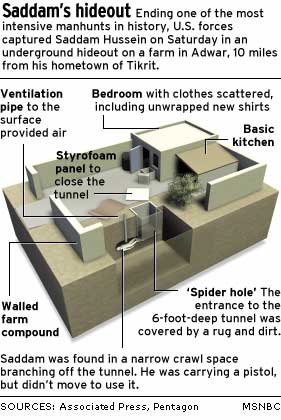Samir, a 34-year-old Iraqi-American military interpreter who helped find Saddam and pull him from his hideaway in December 2003.
Red Dawn was the operation launched to capture or kill Saddam Hussein in 2003. Named after the 1984 movie that started Patrick Swayze.
Background
Hussein disappeared from public view soon after the 2003 invasion of Iraq. The American military labelled him “High Value Target Number One” (HVT1) and began one of the largest manhunts in history. Between July and December 2003, JSOC’s Task Force 121 carried out twelve unsuccessful raids to find Saddam Hussein, together with 600 other operations against targets, including 300 interrogations.
On 12 December 2003, a raid on a house in Baghdad that was being used as an insurgent headquarters captured Muhammed Ibrahim Omar al-Musslit, Saddam’s right-hand man. Early the next morning he revealed where Saddam may be found.
The Raid
Operation Red Dawn was launched after gaining actionable intelligence identifying two likely locations of Saddam’s whereabouts code-named Wolverine 1 and Wolverine 2, near the town of ad-Dawr, south of Saddam’s hometown of Tikrit. The site names of “Wolverine 1” and “Wolverine 2” are also a reference to the American insurgent group in the movie, The Wolverines.

C squadron of 1st SFOD-D, ISA operators under Task Force 121 and the First Brigade Combat team of the 4th ID, conducted the operation. The forces cleared the two objectives but initially did not find the target. Then, as the operators were finishing and the helicopters called in to extract them, one assaulter kicked a piece of flooring to one side, exposing a spider hole; he prepared to throw a fragmentation grenade into it – in case it led to an insurgent tunnel system, when suddenly Hussein appeared. The Delta operator struck him with the stock of his M4 Carbine and disarmed him of a Glock 18C.

Hussein surrendered and offered no real resistance; he was exfiltrated by the 160th SOAR to the Tikrit Mission Support Site where he was properly identified. After proper identification, he was then taken by helicopter from 160th SOAR from Tikrit to Baghdad and into custody at Baghdad International Airport.
There were no casualties in the operation.
Reaction and Aftermath
International reaction to the capture of Hussein was overwhelmingly positive, even in the Arab world.
Saudi Prince Bandar bin Sultan, Saudi ambassador to the United States, stated that “Saddam Hussein was a menace to the Arab world.”
A Jordanian government spokeswoman said they hoped that a page has been turned and that the Iraqi people would be able to assume their responsibilities as soon as possible and build their future according to their will. The first and last word concerning the capture of Saddam Hussein or his fate must be given to the Iraqi people.
Egyptian Foreign Minister Ahmed Maher said, “I don’t think anyone will be sad over Saddam Hussein. His arrest does not change the fact that his regime was finished, and it is the natural consequence of the regime’s fall. The Iraqi regime had harmed the Iraqi people, and had pulled the Arab region into several storms.”
Unfortunately, not all the news was good. Shortly after Saddam’s capture, a long term insurgency wreaked havoc across that country. Shia cleric Muqtada al-Sadr took full advantage of Hussein’s capture by launching a shia uprising without fear if reprisal from the Sunni Ba’athists of Saddam’s regime.

Saddam himself was executed by hanging at Camp Justice, an Iraqi army base in Kadhimiya, a neighborhood of northeast Baghdad by Iraqi authorities on 30 Dec 2006.